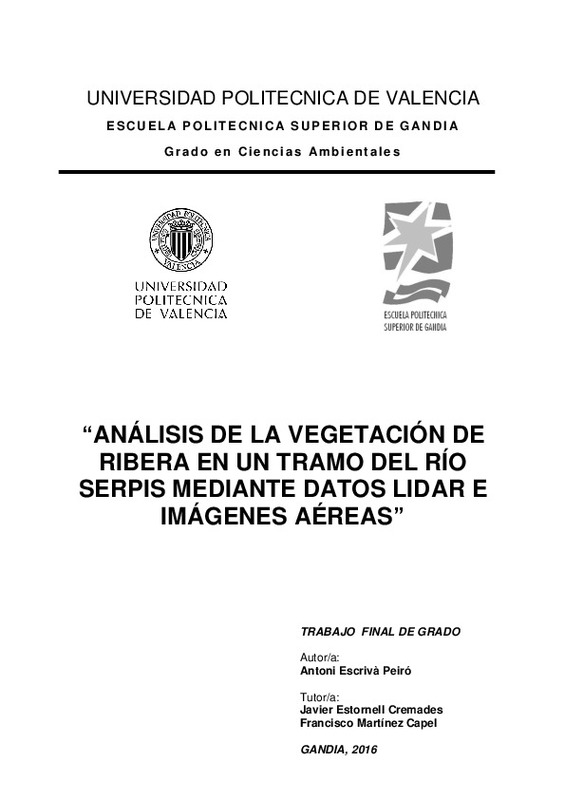JavaScript is disabled for your browser. Some features of this site may not work without it.
Buscar en RiuNet
Listar
Mi cuenta
Estadísticas
Ayuda RiuNet
Admin. UPV
Análisis de la vegetación de ribera en un tramo del río Serpis mediante datos LIDAR e imágenes aéreas
Mostrar el registro sencillo del ítem
Ficheros en el ítem
| dc.contributor.advisor | Martínez Capel, Francisco
|
es_ES |
| dc.contributor.advisor | Estornell Cremades, Javier
|
es_ES |
| dc.contributor.author | Escrivà Peiró, Antoni
|
es_ES |
| dc.date.accessioned | 2017-10-05T15:30:11Z | |
| dc.date.available | 2017-10-05T15:30:11Z | |
| dc.date.created | 2017-09-21 | |
| dc.date.issued | 2017-10-05 | es_ES |
| dc.identifier.uri | http://hdl.handle.net/10251/88837 | |
| dc.description.abstract | In this work it is proposed an alternative system to the traditional methods of field work for the analysis of riparian vegetation afected by the regulation of channels in rough terrain or with hard access. The main goal was to elaborate a mathematical model that allow, combining LiDAR information and espectral information in an optimal way, identify the vegetation phases in a section of the river forest of the Serpis river. For that reason was created a mathematical model able to analyze the images for the prediction of the succesion stages. The methodology used is based on the creation of digital models and the combination of these, vegetation índices and information of LiDAR intensity all together, to finally with the extraction of vegetation classes obtain the mathematical model. The best model obtained offered a Fuzzy Kappa value (similarity grade) of 0,607 with regard to a field work sampling, what tells us that is adequately precise to replace the traditional techniques of field work and this will allow us to keep studying more extensively the vegetation phases of the Serpis river. | es_ES |
| dc.description.abstract | En este trabajo se propone un sistema alternativo a los métodos tradicionales de trabajo de campo para el análisis de la vegetación de ribera afectada por la regulación de cauces en terrenos abruptos o de difícil acceso, los cuales suponen un alto coste de tiempo y dinero. El objetivo principal fue elaborar un modelo matemático que permita, combinando información de LiDAR y espectral de un modo óptimo, identificar las fases de sucesión vegetal en un tramo de bosque fluvial del río Serpis. Para ello se ha creado un modelo capaz de analizar las imágenes para la predicción de las fases de sucesión vegetal. La metodología utilizada se basa en la creación de modelos digitales y la combinación de éstos junto a índices de vegetación e información de intensidad LiDAR, para finalmente junto con la extracción de clases vegetales obtener el modelo matemático en cuestión. El mejor modelo obtenido ofrece un valor Fuzzy Kappa (grado de similaridad) de 0,607 con respecto a un muestreo de campo de referencia, lo que nos indica que es suficiente para sustituir las técnicas tradicionales de trabajo de campo y esto permitirá seguir estudiando de modo más extensivo las fases de vegetación del río Serpis. | es_ES |
| dc.format.extent | 49 | es_ES |
| dc.language | Español | es_ES |
| dc.publisher | Universitat Politècnica de València | es_ES |
| dc.rights | Reserva de todos los derechos | es_ES |
| dc.subject | LiDAR | es_ES |
| dc.subject | Riparian vegetation | es_ES |
| dc.subject | Succesion phases | es_ES |
| dc.subject | Fuzzy Kappa. | es_ES |
| dc.subject | Vegetación de ribera | es_ES |
| dc.subject | Fases de sucesión vegetal | es_ES |
| dc.subject | Modelo matemático | es_ES |
| dc.subject | Rio Serpis | es_ES |
| dc.subject.classification | TECNOLOGIA DEL MEDIO AMBIENTE | es_ES |
| dc.subject.classification | INGENIERIA CARTOGRAFICA, GEODESIA Y FOTOGRAMETRIA | es_ES |
| dc.subject.other | Grado en Ciencias Ambientales-Grau en Ciències Ambientals | es_ES |
| dc.title | Análisis de la vegetación de ribera en un tramo del río Serpis mediante datos LIDAR e imágenes aéreas | es_ES |
| dc.type | Proyecto/Trabajo fin de carrera/grado | es_ES |
| dc.rights.accessRights | Abierto | es_ES |
| dc.contributor.affiliation | Universitat Politècnica de València. Instituto de Investigación para la Gestión Integrada de Zonas Costeras - Institut d'Investigació per a la Gestió Integrada de Zones Costaneres | es_ES |
| dc.contributor.affiliation | Universitat Politècnica de València. Departamento de Ingeniería Hidráulica y Medio Ambiente - Departament d'Enginyeria Hidràulica i Medi Ambient | es_ES |
| dc.contributor.affiliation | Universitat Politècnica de València. Departamento de Ingeniería Cartográfica Geodesia y Fotogrametría - Departament d'Enginyeria Cartogràfica, Geodèsia i Fotogrametria | es_ES |
| dc.contributor.affiliation | Universitat Politècnica de València. Escuela Politécnica Superior de Gandia - Escola Politècnica Superior de Gandia | es_ES |
| dc.description.bibliographicCitation | Escrivà Peiró, A. (2017). Análisis de la vegetación de ribera en un tramo del río Serpis mediante datos LIDAR e imágenes aéreas. Universitat Politècnica de València. http://hdl.handle.net/10251/88837 | es_ES |
| dc.description.accrualMethod | TFGM | es_ES |
| dc.relation.pasarela | TFGM\30051 | es_ES |
Este ítem aparece en la(s) siguiente(s) colección(ones)
-
EPSG - Trabajos académicos [5004]
Escuela Politécnica Superior de Gandia






